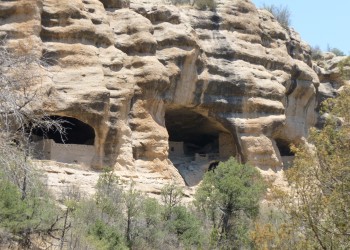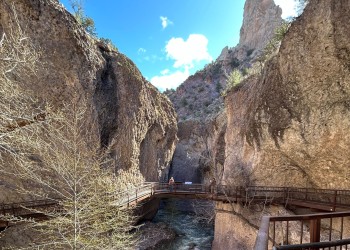Discover History
Remnants of the past are a nearly constant reminder of the history of this landscape, from rock art and cliff dwellings, to mines, CCC-era cabins, roads, and trails, there is history to discover on the Gila.
Gila Cliff Dwellings

The Gila Cliff Dwellings were living quarters used by the Mogollon Culture 1,000 years ago. Located in the heart of the Gila Wilderness, the Cliff Dwellings is a popular jumping-off point for access to the Gila Wilderness.
Catwalk Recreation Area

The Catwalk's history begins in the late 1800s, when gold was discovered in the canyon. A catwalk was constructed for hauling ore from the mine site to the mill. In the early 1900s, the Civilian Conservation Corps rebuilt the catwalk for recreation. A massive flood washed it away in 2013, and the Forest Service rebuilt the Catwalk again in 2016. The elevated bridges are suspended in the narrow slot canyon above Whitewater Creek.
Arrastra Interpretive Site

During its mining heyday, the Pinos Altos area hosted dozens of arrastras, which were used to crush raw gold and silver ore. The example seen at the Arrastra Interpretive Site has been reconstructed so that visitors can understand how an arrastra works.
Walk in the Past Trail

The Walk in the Past Trail is an easy, short walk to a prehistoric rock art panel and the Tularosa Cabin. Tularosa Cabin was the original Forest Service Ranger Station in the area.
Historic Fort Bayard
Visit Historic Fort Bayard and the museum to learn about this area's storied past. Established as a military fort in 1866, the fort provided security against Apache raids during settlement. Later, it was the site of the US Army's first tuberculosis hospital, and later a VA hospital, and the Fort Bayard National Cemetery. The former military fort lands are now managed by the Gila National Forest for day use. The Dragonfly Trailhead and Big Tree Trailhead are the most popular access points for area trails.
Stories of the Past
The Mogollon Culture
More than 1,000 years before the white man made his appearance in this part of the Southwest, the Mogollon Mountains northwest of Silver City were inhabited by primitive pithouse and cliff-dwelling people. Exactly what became of the cliff people is unknown. For some reason the cave communities were abandoned as well as many later pueblo-type structures that have been unearthed throughout southwestern New Mexico. Excellent examples of the cliff dwellings can be seen at the Gila Cliff Dwellings National Monument.
The Mimbres people (a subset of the Mogollon Culture) developed distinctive pottery with intricate, baked on patterns. The Western New Mexico University Museum in Silver City and the Geronimo Springs Museum in Truth or Consequences display many fine examples of the Mimbres peoples' work.
Apache People
After the disappearance of the Mogollon culture, Apache people arrived from the north, roaming and using the Gila landscape for hunting and gathering. Other than pits for roasting agaves, the Apache left little visual evidence of their passing. However, the Apache's' impact would be fiercely felt by miners and homesteaders attempting to settle here.
Well known Apache figures such as Mangas Colorados, Victorio, Lozen, Cochise, Nana, and Geronimo made this place their nomadic homeland and defended it fiercely. The Chiricahua National Monument provides a history of the Apache Wars in Part 1 and Part 2.
The Settlers
Spanish explorers, priests, and entrepreneurs began visiting the Gila landscape in the 1600s, with varying degrees of welcome from the resident bands of Apache. In 1800, an Apache showed a Spanish officer a copper deposit at the location of the present-day Chino Mine at Santa Rita, New Mexico. The Spaniards developed the mine, sending pack trains of mules to Chihuahua, Mexico to be used for Spanish coinage in Mexico.
Through the 1800s more white people came and settled the Gila landscape, always having to contend with hostile natives. The fierce Apache raids upon settlers were not entirely unprovoked. In 1835, on the Upper Gila, a man named James Johnson invited the nearby Apache, men, women, and children to a party, complete with gifts. When Johnson's howitzer cut loose on the unsuspecting guests, 20 of the 35 Apache were slain, and all but three or four of the remaining were shot or their skulls crushed by Johnson's friends. This event turned Chief Mangas Colorados (Red Sleeves) from a peaceful leader of the Apache into a violent leader whose only problem was who to kill next.
The pace of settlement increased after the California Gold Rush of 1849 and as the Civil War was heating up, with a flood of prospectors, miners, stockmen, and homesteaders moving west. Whitewater Canyon, the site of the modern-day Catwalk Recreation Area was a central point in the mining saga. The town of Graham, also called Whitewater, grew up around a mill built by John T Graham in 1893. This part of the New Mexico territory grew slowly because of the Apache threat until the discovery of gold by James C. Cooney. Earlier settlements of farmers were driven out by the Apache. Finally to protect these pioneers, the US Government built a series of military forts in the region, including Fort Bayard where Cooney was stationed. Cooney found gold and silver deposits while on a scouting mission but could do nothing to develop his discoveries until he was discharged from the service in 1875. He then organized a party to prospect the district. Among the party was John Lambert, who found rich gold and silver ore just above Whitewater Canyon.
The mines developed from the Lambert findings include the Confidence, Bluebird, Blackbird, and Redbird, which fed the mill in Graham. Some of these mines were dug to a depth of 1,000 feet. Cooney was able to work his claims for only 4 years, from 1876 to 1880. On April 8, 1880, he and his companion William Chick were riding to warn settlers of an impending Apache attack, when they were killed by Victorio and his Apaches. Cooney's mutilated body was found by friends who carved a grave out of a huge boulder. Cooney's tomb can be found on Mineral Creek north of Whitewater Canyon.
Outlaws
There is little to remind the modern visitor to the Gila National Forest that less than 100 years ago bloody struggles raged between settlers and Apaches. Miners, who discovered bonanzas in gold and silver in the Mogollon Mountains never strayed far from their weapons. As the Apache threat reduced, outlaws appeared in the rich mining towns that dotted the high mountains near the big gold strikes.
Among the residents of Graham at Whitewater Canyon were Mr. and Mrs. William Antrim. Antrim was the town blacksmith. The couple's only claim to fame came through Mrs. Antrim's infamous son, known to the world as Billy the Kid.
It was in this area that the Kid first saw the inside of a jail. Sheriff Harvey H. Whitehill said in an old newspaper interview that William Bonney only got a scolding for his first offense, the stealing of several pounds of butter. Kid's next scrape with the law involved the theft of $70 from a Chinese merchant in Silver City. This time the 18-year-old Kid was jailed, but escaped by climbing up the chimney. Billy the Kid was dead at 21, but not before leaving a trail of crime and murder across the Southwest.
The Wild Bunch, led by Buch Cassidy, was known in this area in 1899 only as hardworking cowhands employed by the WS Ranch near Glenwood. But when they felt the need for cash they terrorized the country as far north as Wyoming with robberies and killings.
On one of their forays the Wild Bunch was careless in covering their tracks. Pinkerton detectives trailed them to Alma, another mining town. The Bunch, also known as the Hole In The Wall Gang was forced to hide in the same Whitewater Canyon that was used as a hideout by Apache chiefs Geronimo and their bands.


